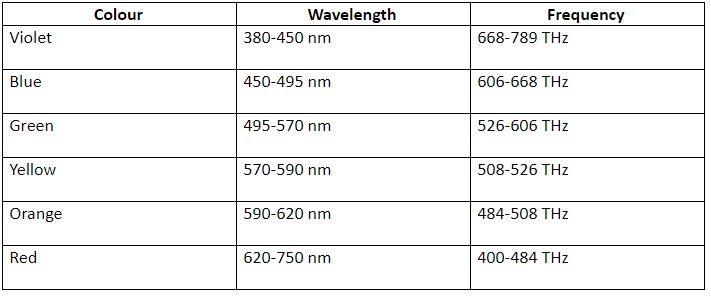
The wavelength of visible light is:
A. 200nm-370nm
B. 780nm-890nm
C. 380nm-760nm
D. 900nm-2000nm
Answer
511.5k+ views
Hint- As we know, Wavelength of light is designated as the distance between the two successive crests of the light wave. Therefore, we simply say the distance between either one crest or trough of one wave and the next wave is called wavelength. And It is denoted by the letter lambda (λ).
Complete step-by-step answer:
Mathematically, wavelength of light calculated:
As light has the properties of a wave as well as particle, it can be expressed as:
Where, c- speed of light
The wavelength for various colours of the visible range of spectrum of light is provided in the below table underneath.

Typically, it’s 400nm to 700nm (Violet to Red) but we have some sensitivity to UV below 400nm (about 10 to 20nm I think) and some sensitivity to IR above 700nm - up to around 1350nm. After that, we might still have sensitivity, but the resultant energy from the light would damage our eyes rather than be simply detected.
Therefore, roughly it is from 400nm to 750 nm. The lens in your eye absorbs below 400 nm. In days before the use of lens inserts, people could see down to 350 nm after cataract surgery (removal of the natural lens). The long wave limit is not sharp and you might see something out near 800nm.
Note- Remember always, We can see that visible spectrum have wavelength range of 400nm to 700nm but in Angstrom we can also say 4000
Complete step-by-step answer:
Mathematically, wavelength of light calculated:
As light has the properties of a wave as well as particle, it can be expressed as:
Where, c- speed of light
The wavelength for various colours of the visible range of spectrum of light is provided in the below table underneath.

Typically, it’s 400nm to 700nm (Violet to Red) but we have some sensitivity to UV below 400nm (about 10 to 20nm I think) and some sensitivity to IR above 700nm - up to around 1350nm. After that, we might still have sensitivity, but the resultant energy from the light would damage our eyes rather than be simply detected.
Therefore, roughly it is from 400nm to 750 nm. The lens in your eye absorbs below 400 nm. In days before the use of lens inserts, people could see down to 350 nm after cataract surgery (removal of the natural lens). The long wave limit is not sharp and you might see something out near 800nm.
Note- Remember always, We can see that visible spectrum have wavelength range of 400nm to 700nm but in Angstrom we can also say 4000
Latest Vedantu courses for you
Grade 11 Science PCM | CBSE | SCHOOL | English
CBSE (2025-26)
School Full course for CBSE students
₹41,848 per year
EMI starts from ₹3,487.34 per month
Recently Updated Pages
Master Class 9 General Knowledge: Engaging Questions & Answers for Success

Master Class 9 English: Engaging Questions & Answers for Success

Master Class 9 Science: Engaging Questions & Answers for Success

Master Class 9 Social Science: Engaging Questions & Answers for Success

Master Class 9 Maths: Engaging Questions & Answers for Success

Class 9 Question and Answer - Your Ultimate Solutions Guide

Trending doubts
State and prove Bernoullis theorem class 11 physics CBSE

What are Quantum numbers Explain the quantum number class 11 chemistry CBSE

Who built the Grand Trunk Road AChandragupta Maurya class 11 social science CBSE

1 ton equals to A 100 kg B 1000 kg C 10 kg D 10000 class 11 physics CBSE

State the laws of reflection of light

One Metric ton is equal to kg A 10000 B 1000 C 100 class 11 physics CBSE




